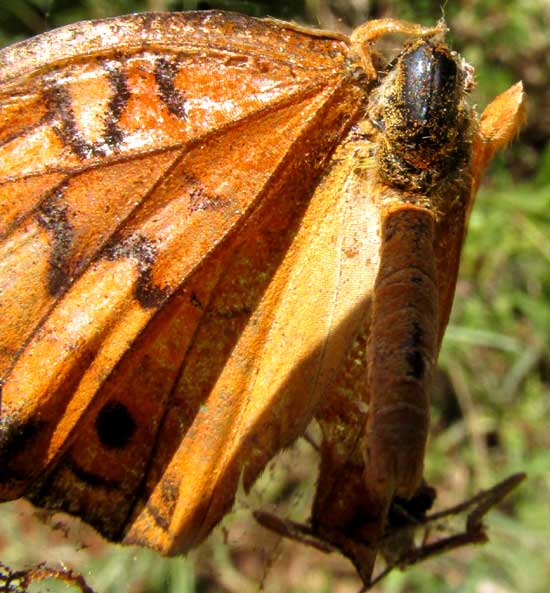Excerpts from Jim Conrad's
Naturalist Newsletter
from the June 19, 2016 Newsletter issued from Hacienda Chichen Resort beside Chichén Itzá Ruins; limestone bedrock; elevation ~39m (~128ft), N20.675°, W88.569°; central Yucatán state, MÉXICO
VARIEGATED FRITILLARIES
Something special about these days is that, on a healthy clump of Yellow Cosmoses planted beside the hut door, from dawn to dusk every day, normally at least eight to ten orangish Variegated Fritillary butterflies are flitting about, sometimes more. I love sitting nearby watching, wondering how they can remain so active in the intense sunlight and heavy heat. Below, you can see a Variegated Fritillary, EUPTOIETA CLAUDIA, on a cosmos blossom:
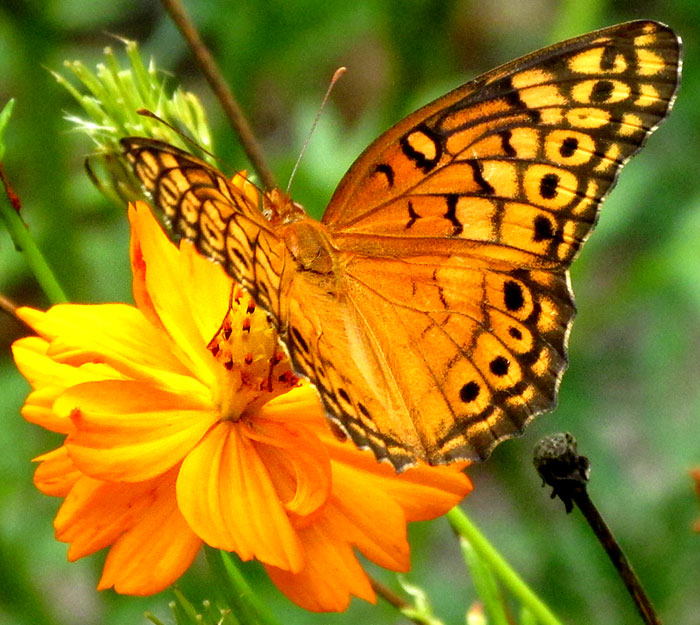
One reason so many Variegated Fritillaries frequent the cosmoses is that this is a widely distributed species specializing in open, sunny areas, including fields, pastures, road edges, landfills and such, and thus it's one that benefits -- at the expense of others -- from human disruption of the landscape. Originally Variegated Fritillaries specialized in prairies and other such open natural environments, but nowadays roadsides and flowerbeds next to huts suit them just fine. They distributed from Argentina north through Central America, Mexico and the Caribbean, to most of the US.
Variegated Fritillary caterpillars feed on species of several plant families, including the Passionflower and Purslane Families, which commonly occur here. Adults take nectar from many kinds of flowering plants, including members of the Milkweed, Dogbane and Sunflower or Composite Family, which are abundant here.
from the July 10, 2016 Newsletter issued from Hacienda Chichen Resort beside Chichén Itzá Ruins; limestone bedrock; elevation ~39m (~128ft), N20.675°, W88.569°; central Yucatán state, MÉXICO
MATING VARIEGATED FRITILLARIES
I'm tickled with the picture of mating variegated fritillary butterflies shown below:
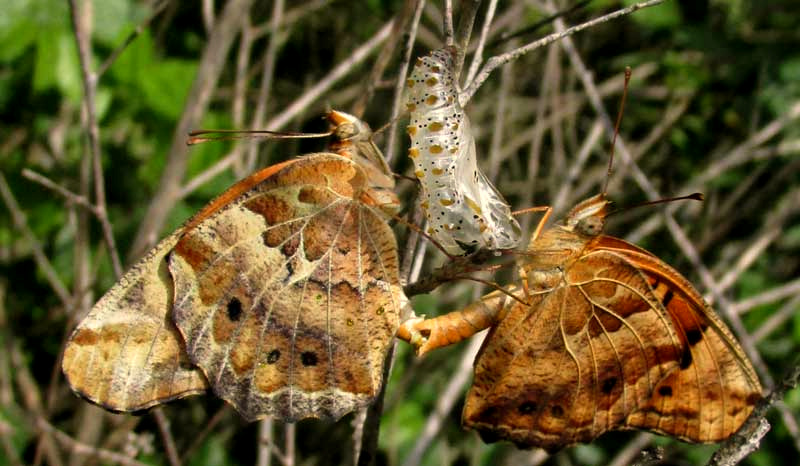
Not only does it show how they do it, and that the two butterflies are somewhat differently colored, but also they're hanging onto a pale, discarded casing of a chrysalis, a chrysalis being the resting or pupal stage in butterfly metamorphosis occurring between the caterpillar and the winged adult stages.
It's hard to resist believing that the female had just emerged from her chrysalis, ripely emitting powerful sexual pheromones, and a male came along and got her maybe even before her wings were dry.
She must have been redolent of pheromones, for as I took the picture another male, sometimes two males, and once even a male of a different species -- some kind of yellow sulfur butterfly -- flitted around the pair, evidently wanting some of the action. Below, you can see one of the invaders in midair:
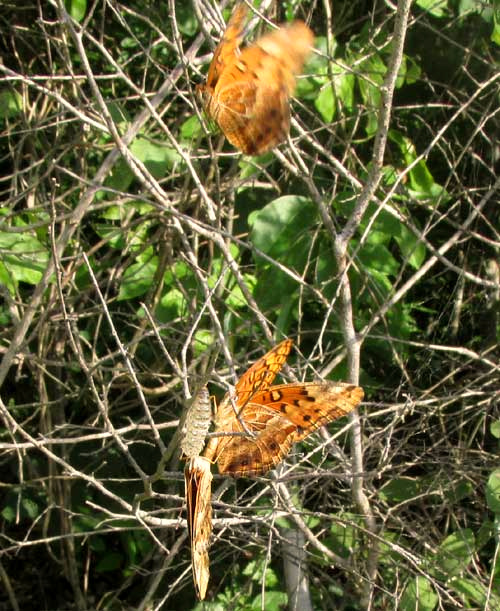
My presence unnerved the male a couple of times, so that he tried to fly away, but the female refused to move and anchored him there as he beat his wings. Later while watching Variegated Fritillaries feeding at the cosmoses next to my hut, a mating pair landed, with one doing all the flying and the other just riding along, being pulled through the air backwards. My impression is that when fritillaries mate it's a slow process and one that doesn't end until it's all done.
The number of Variegated Fritillaries on the landscape now is amazing. Not far from where the above pictures were taken, a bathtub-size bunch of white-flowering Scorpion Tails, or heliotropes, was much occupied with them. A small part of the plant with some visitors is shown below:
from the July 24, 2016 Newsletter issued from Hacienda Chichen Resort beside Chichén Itzá Ruins; limestone bedrock; elevation ~39m (~128ft), N20.675°, W88.569°; central Yucatán state, MÉXICO
AN ORNATE FRITILLARY CHRYSALIS
Deep in the forest, at about chest height, attached to bark on the lower surface of a tree trunk leaning toward sunlight, an especially pretty butterfly chrysalis "exuvia" turned up -- an exuvia being the remains of a molted arthropod such as a scorpion or an insect. It's shown below:
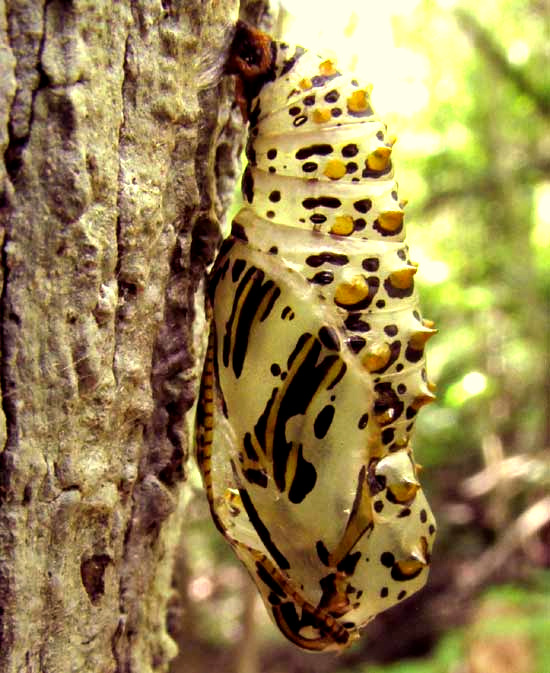
It looked like the same kind of chrysalis exuvia we saw the other day, with a presumably just-emerged female Variegated Fritillary on it, already mating before she'd had a chance to explore her world. However, I wasn't sure of the ID, so I sent it off to volunteer identifier Bea in Ontario; she says she's pretty sure it's that species, so that's what we'll call it.
One reason I hesitated over the name is that there in deep forest where the exuvia was photographed, the forest floor was so shadowy that no wildflowers were present blossoming. Out in the fields and along roads where many plants are flowering nowadays, Variegated Fritillaries are abundant, but they're seldom seen in the forest.
from the July 27, 2018 Newsletter issued from Rancho Regenesis in the woods ±4kms west of Ek Balam Ruins; elevation ~40m (~130 ft), N~20.876°, W~88.170°; central Yucatán, MÉXICO
FRITILLARY MEETS SPIDER
Each morning when I water the garden a good number of butterflies are attracted, for they like to perch on the ground basking as they suck up moisture loaded with the soil's minerals, or maybe a rainbow of nutrients in solution on wet burro turds used as fertilizer. It's good seeing so many butterflies flitting about, getting exactly what they're wanting.
One morning this week, however, a certain orangish Variegated Fritillary got caught in the web of a golden morph of the Spined Micrathena spider. Below, you can see what it looked like as the spider approached the frantically struggling butterfly, right before the spider bit it behind the head:
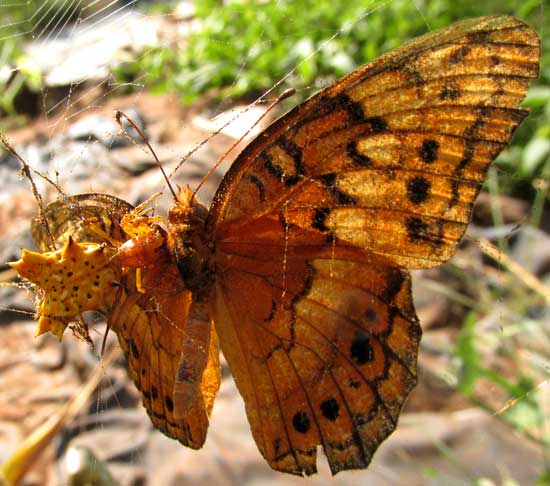
The moment when the spider's venom-injecting fangs pierced the butterfly's exoskeleton is shown below:
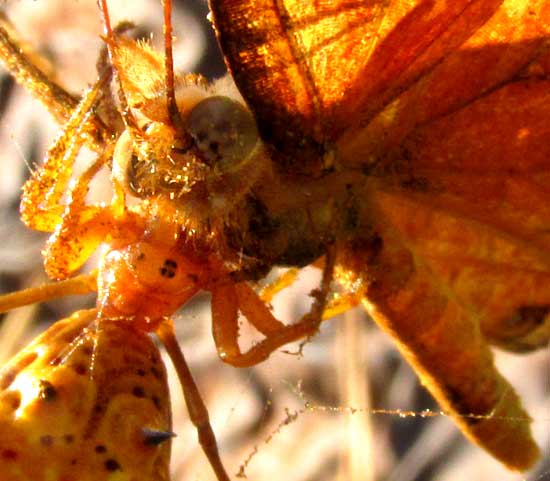
In that picture if you look closely, right below the fritillary's dark, rounded compound eyes, you can see the spider's two broad, elongated "jaws," or chelicerae, inserted into the golden fuzz behind the head. At the very bottom of the chelicerae the hidden fangs are injecting venom. Immediately below the chelicerae on the spider's "face," are four black points, which are eyes. Smaller eyes appear at the side.
I felt sorry for the fritillary, but also empathized with the spider's need to eat. It's just how Nature is set up, and I'm in no position to question the matter. About an hour after the last photo was taken, the fritillary had been reduced to a rather dry mummy, many of the wings' golden scales now dusting the butterfly's face, and the spider seems to have cut off the legs. Below, you can see the sad scene:
